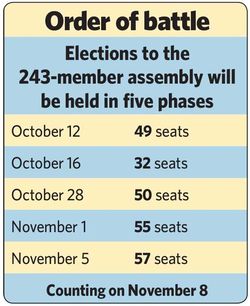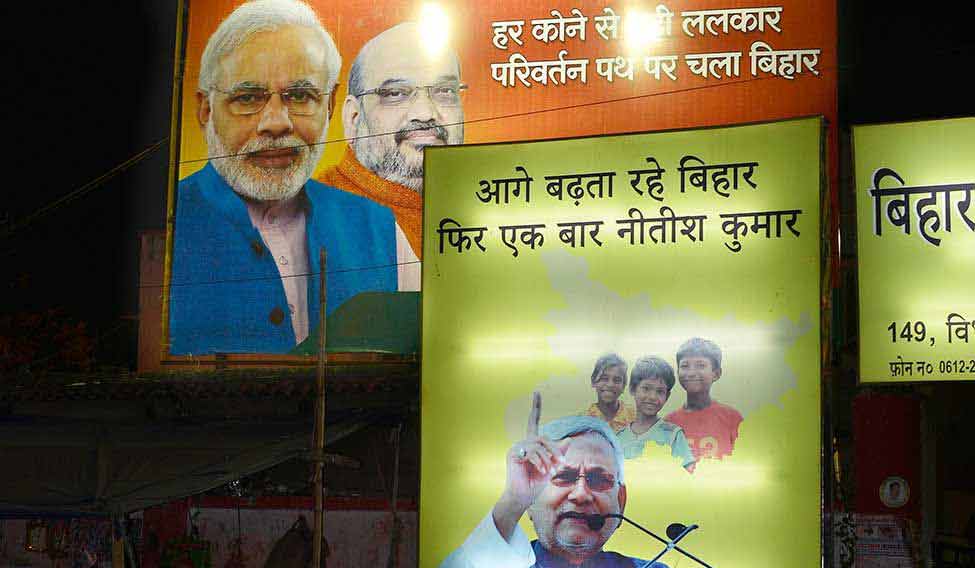At 1.30pm on September 9, the Union government announced a 6 per cent hike in the dearness allowance for its employees and pensioners. Three minutes later in Patna, Chief Minister Nitish Kumar made a similar announcement. He, too, declared a 6 per cent DA hike for state government employees and pensioners. Union Finance Minister Arun Jaitley said the revision was a routine half-yearly exercise. Nitish said state governments always followed the Centre in such matters.
Both Jaitley and Nitish beat the Election Commission by a few minutes. For, at 2pm, Chief Election Commissioner Nasim Zaidi announced that Bihar would go to the polls in five phases from October 12 to November 5 to elect members to the next Vidhan Sabha. With the announcement, the model code of conduct, too, came into effect.
The battle for Bihar, which is being fought for more than a year, has finally become official with the EC's announcement. Strategising has become more hectic, the queues of ticket seekers outside party offices have become longer, and there is also a realisation among political parties that they cannot continue to spend the way they used to. “There will be zero tolerance to prejudice or bias in enforcing it,” said Zaidi about the code of conduct. With the Commission putting in place arrangements to ensure free, fair and peaceful elections, Zaidi urged voters to resist all forms of allurement and participate in the process to strengthen democracy.
Despite the CEC's best intentions, lavish campaigning for Bihar had started even before the 2014 Lok Sabha elections, when a miffed Nitish broke away from the alliance with the BJP, after Narendra Modi was named the BJP's prime ministerial candidate. The bitterness between the two was even older. During the 2010 assembly elections, which the BJP and the JD(U) fought under his leadership, Nitish ensured that Modi, who was then the chief minister of Gujarat, was not part of the campaign. Nitish was fearful that the presence of Modi would cost him Muslim votes.
In a backward state where people are torn between caste and communal considerations and basic development, a bitter battle is in the making. As of now, it seems to be a straight fight between Nitish and Modi. The BJP's face in the elections is not Sushil Modi, who was the deputy chief minister in the coalition government, but Narendra Modi himself. The prime minister and the chief minister loom larger than life in the neon-lit posters at all vantage points in Patna and occasionally across the highways.
However, Modi and Nitish have not given up on the alliance mantra. The BJP has its Bihar-based National Democratic Alliance Partner Ram Vilas Paswan and his Lok Janshakti Party and the newly formed Hindustani Awam Morcha of former chief minister Jitan Ram Manjhi. Nitish had formed a “grand secular alliance” with the Congress, the Rashtriya Janata Dal of Lalu Prasad, who was once his arch rival, Samajwadi Party of Mulayam Singh Yadav and the Nationalist Congress Party of Sharad Pawar. But Mulayam broke away as he was angry about not being consulted during seat distribution, while the NCP felt it was unfair that the Congress with just two MPs was given 40 seats. Although Mulayam initially announced that his party would contest on its own, he was later in talks with the NCP in an attempt to forge a third front. “In any case, Mulayam Singh would only have been a symbolic partner. Where are his supporters in Bihar?” asked Dinesh Singh, the Saran district president of the JD(U).

While Lalu has endorsed Nitish for CM, his supporters are pitching for a proportionate share of tickets claiming that 70 per cent of the people who participated in the samman rally of the “secular alliance” belonged to the RJD.
The BJP, meanwhile, is upbeat about its chances. “The people have already come forward to decide. They were happy to be out of the jungle raj when the BJP-JD(U) government was formed under Nitish's leadership. But now that Nitish is back in Lalu's lap, the verdict will be against jungle raj,” said Sanjay Mayukh, MLC and vice president of the BJP's Bihar unit. He said the elections would mark the beginning of the end of Nitish's political career.
Nitish, however, said the people would vote for development. “My one-point agenda-cum-manifesto is development,” he said.
Modi is scheduled to address 32 parivartan (change) rallies across Bihar. He has already covered four locations. The BJP's 243 video vans called Parivartan Raths are halting at every village, showing people a video clip on why change is necessary. Is bar, bhajpa sarkar (This time, a BJP government) is the party's slogan. The BJP has never ruled Bihar on its own, although it was a coalition partner with Nitish's JD(U) for nearly eight years.
The election is projected as a war between those who represent development and those who stand for a casteist and communal society. Both Modi and Nitish claim to represent development-oriented politics and governance in the state as they prepare for a bitter ballot battle.







